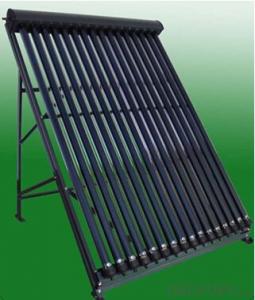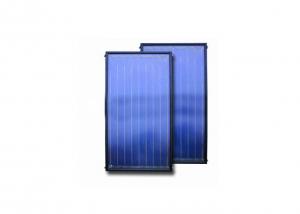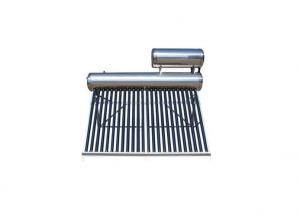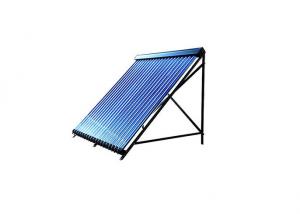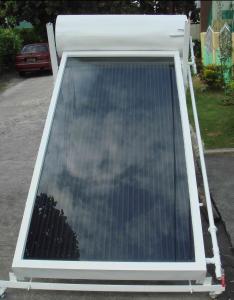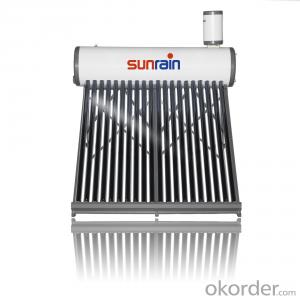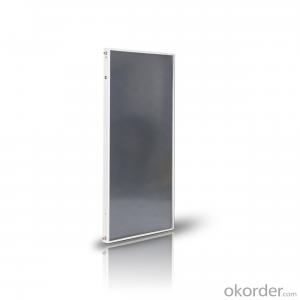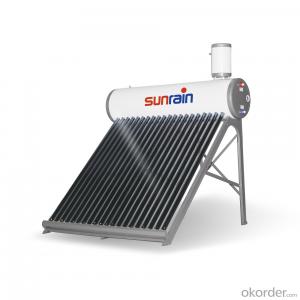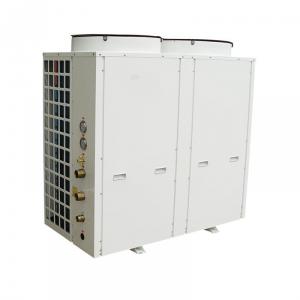150L Solar Water Heater with Feeding Tank
- Loading Port:
- Shanghai
- Payment Terms:
- TT OR LC
- Min Order Qty:
- 10 set
- Supply Capability:
- 5000 set/month
OKorder Service Pledge
OKorder Financial Service
You Might Also Like
Introduction of Non-Pressure Solar Water Heater:
Non-pressure Solar Heater is one of the most economical solar water heating device with pretty high efficiency at the same time. It consists of hot water storage tank, solar vacuum tubes with mouth plug in storage tank, and bracket supporting tank and tubes.When cold water in evacuated tubes is heated with solar irradiation, as the specific gravities of hot water and cold water are different, hotter water goes upward to storage tank and colder water goes downward to glass tubes. through this continuous circulation, the cold water in storage tank will be gradually heated till sunset.
Features:
1. High thermal performance and working temperature: the heat exchanging rate even in winter can up above 55%.
2. Heat collecting efficiency is at least 20% above common solar systems.
3. Work in all day and all season: no matter any corner of the world, this system can work well even -40℃ to avoid the tube freezing problem.
4. Reliability: No water following through the tube, so water scale can not generate and tube cracks could be avoided, the system still can keep working even with some damaged tubes.
5. It can connect with water tap and work automatically with pressure0.6Mpa, bring enjoyable washing experience.
6. Safety: P/T valve would release pressure and temperature to protect tank..
Specification
ITEM.NO | SPECIFICATION | EFFECTIVE LIGHT AREA | TANK'S CAPACITY | APPLICATION PEOPLE | CBM | |||
DIAMETER OF WATER TANK | QTY OF TUBE(pcs) | DIAMETER OF TUBE | LENGTH OF TUBE | |||||
Z-NS5810 | 460mm | 10 | 58mm | 1.8m | 1.04 | 100L | 4 | 0.37 |
Z-NS5812 | 460mm | 12 | 58mm | 1.8m | 1.25 | 120L | 4-5 | 0.44 |
Z-NS5815 | 460mm | 15 | 58mm | 1.8m | 1.56 | 150L | 6 | 0.56 |
Z-NS5818 | 460mm | 18 | 58mm | 1.8m | 1.87 | 180L | 7-8 | 0.64 |
Z-NS5820 | 460mm | 20 | 58mm | 1.8m | 2.08 | 200L | 8 | 0.7 |
Z-NS5825 | 460mm | 25 | 58mm | 1.8m | 2.61 | 250L | 10 | 0.89 |
Z-NS5830 | 460mm | 30 | 58mm | 1.8m | 3.13 | 300L | 12 | 1 |
Z-NS5836 | 460mm | 36 | 58mm | 1.8m | 3.75 | 360L | 14-15 | 1.3 |
Z-NS5840 | 460mm | 40 | 58mm | 1.8m | 4.17 | 400L | 16 | 1.4 |
Z-NS5845 | 460mm | 45 | 58mm | 1.8m | 4.69 | 450L | 18 | 1.6 |
Product Details Show:


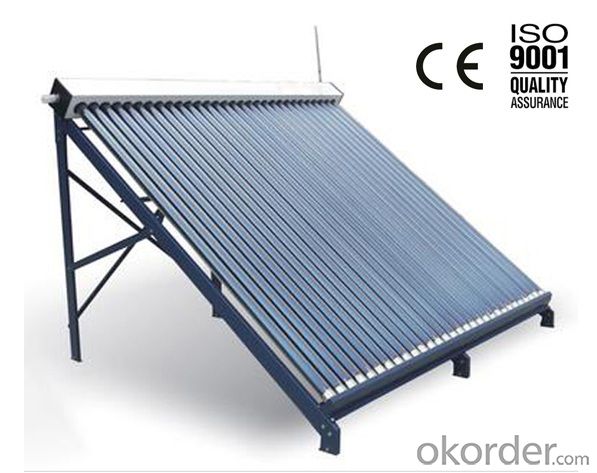
FAQ
1. Q: Are you a factory or trading company?
A: We are a factory. Especially for Solar Controller, PWM solar controller 50A12V/24V
2. Q: Where is your factory located? How can I visit there?
A: Our factory is located in Guangzhou, China. You are warmly welcomed to visit us!
3. Q: what other product you have except such Solar Lighting?
A: We have poly ,mono cells and panels. Off grid solar system, like off grid solar inverter, pure sine wave inverter, solar collector, solar controller, solar charger, Portal solar system, battery, DC Fan, Solar Led Light.
4. Q: Can the price be cheaper?
A: Of course, you will be offered a good discount for big amount.
5. How can I get a sample?
A: Please call us or send email for asking the samples.
- Q:Can a solar water heater be used in areas with frequent hurricanes or storms?
- Yes, a solar water heater can be used in areas with frequent hurricanes or storms. However, additional precautions need to be taken to ensure the system's durability and safety during extreme weather events. Proper installation, securing the system against strong winds, and appropriate maintenance can help mitigate potential damage and ensure reliable operation even in storm-prone areas.
- Q:Can a solar water heater be used in areas with low water pressure?
- Yes, a solar water heater can be used in areas with low water pressure. Solar water heaters work by utilizing the sun's energy to heat the water, and they typically rely on a separate water tank or storage system. As long as the water supply is sufficient to fill the tank, low water pressure should not significantly impact the functioning of a solar water heater. However, it is advisable to consult with a professional or the manufacturer to ensure that the specific solar water heater model is suitable for low water pressure conditions.
- Q:What certifications or standards should a solar water heater meet?
- To ensure efficiency, safety, and compliance with industry regulations, a solar water heater must adhere to specific certifications and standards. Below are some significant certifications and standards that a solar water heater should satisfy: 1. The Solar Rating and Certification Corporation (SRCC): SRCC is a well-known certification organization that evaluates and rates the performance of solar energy systems, including solar water heaters. Their certification guarantees that the system meets precise performance and durability criteria. 2. The International Organization for Standardization (ISO): ISO has numerous applicable standards for solar water heaters. ISO 9459-2 provides guidelines for testing and calculating the thermal performance of solar water heaters, while ISO 9806 covers the testing and rating of solar thermal collectors. 3. The European Solar Keymark: This certification is exclusive to the European Union and serves as a mark of quality and compliance with European standards for solar thermal products. It ensures that the solar water heater meets the necessary performance and safety standards. 4. National or regional building codes: Solar water heaters must comply with the specific building codes of the region where they are installed. These codes outline particular requirements for the design, installation, and safety aspects of solar water heating systems. 5. Safety certifications: Solar water heaters should meet safety certifications like the Underwriters Laboratories (UL) certification in the United States or the TUV certification in Europe. These certifications guarantee that the product has undergone thorough testing to ensure its safety and proper functioning. 6. Energy Star: Although primarily associated with energy-efficient appliances, the Energy Star program also covers solar water heaters. The Energy Star label indicates that the product meets certain energy efficiency criteria, enabling consumers to identify the most energy-efficient options. By fulfilling these certifications and standards, a solar water heater demonstrates its quality, performance, and compliance with industry regulations. This, in turn, instills confidence in consumers regarding its reliability and efficiency.
- Q:What is the expected lifespan of solar water heater components?
- The expected lifespan of solar water heater components can vary depending on various factors such as the quality of the components, maintenance and usage practices, and environmental conditions. However, on average, solar water heater components can last anywhere between 10 to 20 years or more with proper care and maintenance.
- Q:Are there different types of solar water heaters available?
- Yes, there are different types of solar water heaters available.
- Q:Are there any noise-related issues with solar water heaters?
- No, solar water heaters do not produce any noise as they rely on passive processes to heat water, such as sunlight absorption and heat transfer through pipes.
- Q:What is the impact of nearby tall trees or vegetation on the performance of a solar water heater?
- The performance of a solar water heater can be significantly affected by tall trees or vegetation in the vicinity. To achieve maximum sunlight exposure throughout the day, the efficiency of the solar water heater relies on unobstructed access to sunlight. However, when tall trees or dense vegetation are present near the solar water heater, they cast shadows on the solar panels, thereby reducing the amount of sunlight that reaches the system. These shadows created by nearby trees or vegetation can block a substantial portion of sunlight, resulting in reduced energy production and a decline in heating performance. Consequently, the water temperature decreases, and the overall efficiency of the solar water heater diminishes. Moreover, the presence of trees or vegetation can also impact the airflow around the solar panels, affecting the dissipation of heat and potentially leading to overheating. Hence, maintaining proper airflow is crucial to ensure the solar water heater operates at its optimal temperature. In such cases, regular maintenance and monitoring become necessary to guarantee that the solar panels remain unobstructed and free from any debris or fallen leaves. It may be necessary to trim or remove nearby trees or vegetation that cast shadows on the solar panels to improve the performance of the solar water heater. To summarize, the proximity of tall trees or vegetation can have adverse effects on the performance of a solar water heater, as they obstruct sunlight and interfere with airflow. To maximize the efficiency and effectiveness of the solar water heating system, regular maintenance and monitoring, along with potential trimming or removal of trees, are vital.
- Q:Can a solar water heater be integrated with other renewable energy systems?
- Certainly! A solar water heater has the potential to be combined with various other renewable energy systems. This integration offers a comprehensive and efficient method of addressing the energy requirements of a building or household. For instance, by linking a solar water heater to a solar photovoltaic (PV) system, the generated electricity can be used to power the water heater's pump or auxiliary systems. Consequently, any excess electricity produced by the PV system can be employed to heat water, thereby reducing the reliance on conventional grid electricity. Moreover, a solar water heater can also be integrated with other renewable energy sources like wind or geothermal. In regions abundant with wind energy, it is possible to connect a wind turbine to the same grid as the solar water heater. This allows for the utilization of wind power to supplement solar energy in heating water. Similarly, in areas with access to geothermal resources, a geothermal heat pump can be used in conjunction with the solar water heater to provide efficient heating and cooling for the water. The integration of diverse renewable energy systems provides a sustainable and resilient energy solution. By harnessing multiple sources of renewable energy, the overall energy generation and consumption can be optimized, thereby reducing dependence on fossil fuels and minimizing environmental impact. Additionally, the combination of different renewable energy technologies ensures a more reliable and consistent energy supply, as the availability of one resource can compensate for the variability of another. In conclusion, integrating a solar water heater with other renewable energy systems is a viable and advantageous approach to maximizing energy efficiency and sustainability. This approach allows for the utilization of multiple renewable resources, reduces reliance on traditional energy sources, and contributes to a greener and more resilient energy future.
- Q:Solar water heater vacuum tube length?
- Solar energy is a clean and free energy, and now the technology of solar energy is very mature
- Q:Can a solar water heater be used in areas with limited access to installation services?
- Yes, a solar water heater can be used in areas with limited access to installation services. Solar water heaters are relatively simple and can be installed by individuals with basic plumbing skills. Additionally, there are portable and DIY solar water heater kits available that can be easily assembled and used without the need for professional installation services.
1. Manufacturer Overview |
|
|---|---|
| Location | |
| Year Established | |
| Annual Output Value | |
| Main Markets | |
| Company Certifications | |
2. Manufacturer Certificates |
|
|---|---|
| a) Certification Name | |
| Range | |
| Reference | |
| Validity Period | |
3. Manufacturer Capability |
|
|---|---|
| a)Trade Capacity | |
| Nearest Port | |
| Export Percentage | |
| No.of Employees in Trade Department | |
| Language Spoken: | |
| b)Factory Information | |
| Factory Size: | |
| No. of Production Lines | |
| Contract Manufacturing | |
| Product Price Range | |
Send your message to us
150L Solar Water Heater with Feeding Tank
- Loading Port:
- Shanghai
- Payment Terms:
- TT OR LC
- Min Order Qty:
- 10 set
- Supply Capability:
- 5000 set/month
OKorder Service Pledge
OKorder Financial Service
Similar products
New products
Hot products
Hot Searches
Related keywords
